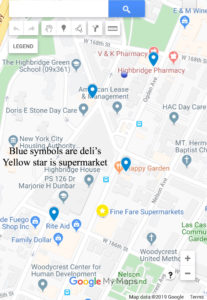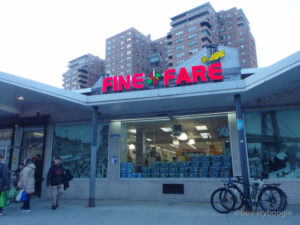Cheyenne Shambley
Professor Michael
Eng110
November 18, 2019
Bodegas Vs. Supermarkets: The Need for Healthier Choices

You would think that living in New York, you would have access to many options of food. That may be the case in other boroughs, but not in the South Bronx. Although New York is known for its food, residents in the South Bronx have limited access to food due to lack of supermarkets. They depend on bodegas for their food needs and though it is more convenient for them to go to, there isn’t many choices for them to get nutritional foods to feed their families. Ultimately what is at stake here is the health of people who aren’t getting healthy foods in their diets. So they depend on what they have which results in fast food from the bodegas that are unhealthy leading to obesity and other health problems.
There should be more supermarkets in the South Bronx because it would lessen the chances of the residents having health issues. Having more supermarkets would help them to get the proper food they need to live a healthy lifestyle. Since they depend on bodegas for their food source, they are more at risk of having obesity and other health issues that come with not eating the right food in their diet. Browne, Zambia J. article; “Poor Neighborhoods Lack Access to Supermarkets” he argues that in low income neighborhoods lack access to supermarkets. Secondly, he insists that there are barriers that some New Yorker’s face to obtain healthy to feed their families. Highbridge is a neighborhood in the South Bronx that is in poverty.

Throughout the neighborhoods there are two supermarkets that the residents can go to. Five bodegas exist as well and the residents are more likely to shop there because the prices are high in the supermarkets compared to bodegas. It is more convenient for them as well some of the bodegas are open 24 hours and that is not the case for supermarkets. Robinson, Gail article; “ New York’s Grocery Gap” emphasizes that the biggest number of produce come the South Bronx but the residents are not able to purchase it because it is a wholesale market and its not for individual consumers. Robinson verifies “ the high prices are a real obstacle for many poor New Yorker’s”. Robinson is surely right about the prices being high and that is an obstacle for residents who live in poverty. They can’t afford to pay for healthy food if it’s overpriced and aren’t choosing to because it may be out of their spending budgets.
Fixing the problem of having a lack of supermarkets since they can’t build them without pushing the residents out of the neighborhood, programs have been implemented to provide healthy food for residents in the South Bronx. Rivera, Migalia’s blog; “The Bronx Dying from Lack of Nutritious Foods” reaffirms that there are ways to help them get the food they need to stay healthy. Rivera states, “ New York City has implemented a program called Move to Fruits and Vegetables”. By doing so they have helped bring fresh fruits and vegetables to bodegas since they lacked them. I agree that these programs will help the residents but it will take some time for them to get accustomed to eating healthy.
 To conclude this essay, it is an awesome idea that they have made an attempt to change the problem of New Yorker’s in poverty, but it doesn’t necessarily mean that residents will follow the plan and start eating healthy. They have gotten used to eating from bodegas that the idea of trying new things doesn’t seem so good. The prices would have to be close to what they are used to spending if not they won’t buy it. The distance should be close to their homes so they don’t have to travel far. I have experienced these problems as well, at times I find myself going the closest store to get food for me and my kids. The one supermarket from my house is called Fine Fare is highly priced and there aren’t many options for us to choose from that fits in my budget. I go to the farmer’s market to get our vegetables and fruits.
To conclude this essay, it is an awesome idea that they have made an attempt to change the problem of New Yorker’s in poverty, but it doesn’t necessarily mean that residents will follow the plan and start eating healthy. They have gotten used to eating from bodegas that the idea of trying new things doesn’t seem so good. The prices would have to be close to what they are used to spending if not they won’t buy it. The distance should be close to their homes so they don’t have to travel far. I have experienced these problems as well, at times I find myself going the closest store to get food for me and my kids. The one supermarket from my house is called Fine Fare is highly priced and there aren’t many options for us to choose from that fits in my budget. I go to the farmer’s market to get our vegetables and fruits.
Works Cited
- Migdalia Rivera. “The Bronx: Dying from Lack of Nutritious Foods” blog March 9, 2016 https://m.huffpost.com/us/entry/us_9350482
- Gail Robinson. “New York’s Grocery Gap” November 21, 2005 https://www.gothamgazette.com/health/3060-new-yorks-grocpery-ga
- Diane Cardwell. “A Plan to Add Supermarkets to Poor Areas, With Healthy Results” September 23, 2009 https://www.nytimes.com/2009/09/24/nyregion/24super.html
- J Zamgba Browne. “Study: Poor Neighborhoods Lack Access to Supermarkets.” New York Beacon, 2006, p. 2.



